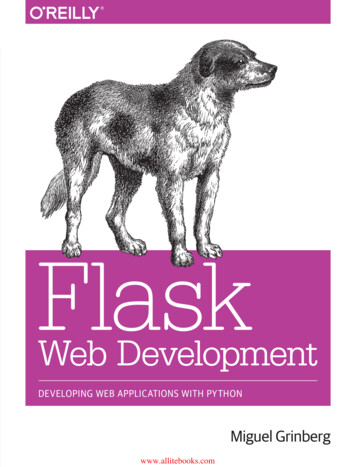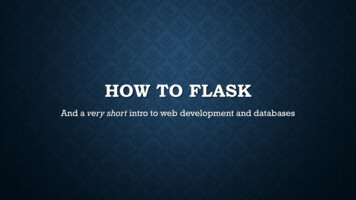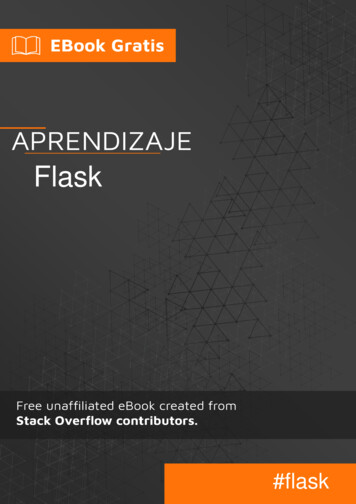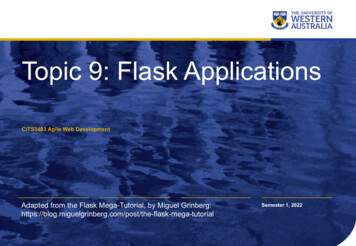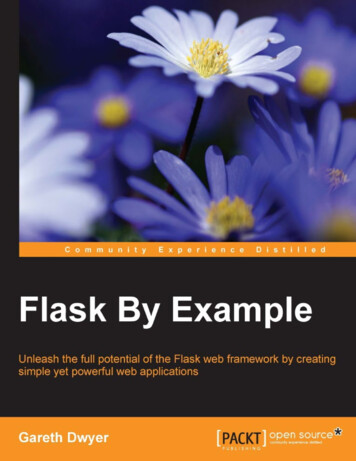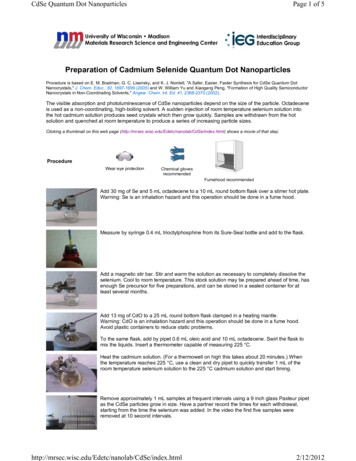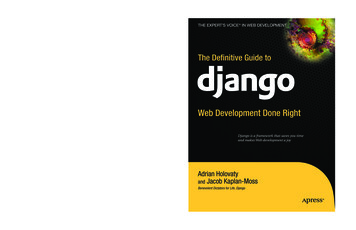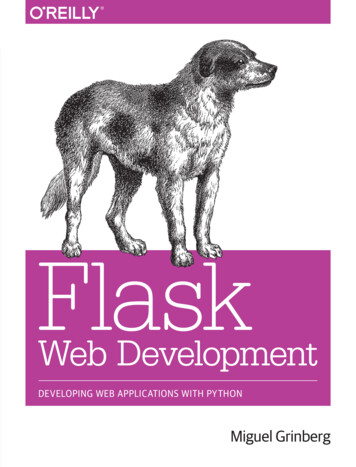
Transcription
Flask Web DevelopmentMiguel Grinberg
Flask Web Developmentby Miguel GrinbergCopyright 2014 Miguel Grinberg. All rights reserved.Printed in the United States of America.Published by O’Reilly Media, Inc., 1005 Gravenstein Highway North, Sebastopol, CA 95472.O’Reilly books may be purchased for educational, business, or sales promotional use. Online editions arealso available for most titles (http://my.safaribooksonline.com). For more information, contact our corporate/institutional sales department: 800-998-9938 or corporate@oreilly.com.Editors: Meghan Blanchette and Rachel RoumeliotisProduction Editor: Nicole ShelbyCopyeditor: Nancy KotaryProofreader: Charles RoumeliotisMay 2014:Cover Designer: Randy ComerInterior Designer: David FutatoIllustrator: Rebecca DemarestFirst EditionRevision History for the First Edition:2014-04-25: First releaseSee http://oreilly.com/catalog/errata.csp?isbn 9781449372620 for release details.Nutshell Handbook, the Nutshell Handbook logo, and the O’Reilly logo are registered trademarks of O’ReillyMedia, Inc. Flask Web Development, the picture of a Pyrenean Mastiff, and related trade dress are trademarksof O’Reilly Media, Inc.Many of the designations used by manufacturers and sellers to distinguish their products are claimed astrademarks. Where those designations appear in this book, and O’Reilly Media, Inc. was aware of a trademarkclaim, the designations have been printed in caps or initial caps.While every precaution has been taken in the preparation of this book, the publisher and authors assumeno responsibility for errors or omissions, or for damages resulting from the use of the information containedherein.ISBN: 978-1-449-37262-0[LSI]
For Alicia.
Table of ContentsPreface. . . . . . . . . . . . . . . . . . . . . . . . . . . . . . . . . . . . . . . . . . . . . . . . . . . . . . . . . . . . . . . . . . . . . . . xiPart I.Introduction to Flask1. Installation. . . . . . . . . . . . . . . . . . . . . . . . . . . . . . . . . . . . . . . . . . . . . . . . . . . . . . . . . . . . . . . . . 3Using Virtual EnvironmentsInstalling Python Packages with pip462. Basic Application Structure. . . . . . . . . . . . . . . . . . . . . . . . . . . . . . . . . . . . . . . . . . . . . . . . . . . 7InitializationRoutes and View FunctionsServer StartupA Complete ApplicationThe Request-Response CycleApplication and Request ContextsRequest DispatchingRequest HooksResponsesFlask ExtensionsCommand-Line Options with Flask-Script7899121214141516173. Templates. . . . . . . . . . . . . . . . . . . . . . . . . . . . . . . . . . . . . . . . . . . . . . . . . . . . . . . . . . . . . . . . . 21The Jinja2 Template EngineRendering TemplatesVariablesControl StructuresTwitter Bootstrap Integration with Flask-BootstrapCustom Error PagesLinks22222324262931v
Static FilesLocalization of Dates and Times with Flask-Moment32334. Web Forms. . . . . . . . . . . . . . . . . . . . . . . . . . . . . . . . . . . . . . . . . . . . . . . . . . . . . . . . . . . . . . . . 37Cross-Site Request Forgery (CSRF) ProtectionForm ClassesHTML Rendering of FormsForm Handling in View FunctionsRedirects and User SessionsMessage Flashing3738404144465. Databases. . . . . . . . . . . . . . . . . . . . . . . . . . . . . . . . . . . . . . . . . . . . . . . . . . . . . . . . . . . . . . . . . 49SQL DatabasesNoSQL DatabasesSQL or NoSQL?Python Database FrameworksDatabase Management with Flask-SQLAlchemyModel DefinitionRelationshipsDatabase OperationsCreating the TablesInserting RowsModifying RowsDeleting RowsQuerying RowsDatabase Use in View FunctionsIntegration with the Python ShellDatabase Migrations with Flask-MigrateCreating a Migration RepositoryCreating a Migration ScriptUpgrading the Database495051515254565758586060606263646465666. Email. . . . . . . . . . . . . . . . . . . . . . . . . . . . . . . . . . . . . . . . . . . . . . . . . . . . . . . . . . . . . . . . . . . . . 69Email Support with Flask-MailSending Email from the Python ShellIntegrating Emails with the ApplicationSending Asynchronous Email697071727. Large Application Structure. . . . . . . . . . . . . . . . . . . . . . . . . . . . . . . . . . . . . . . . . . . . . . . . . . 75Project StructureConfiguration OptionsApplication Packagevi Table of Contents757678
Using an Application FactoryImplementing Application Functionality in a BlueprintLaunch ScriptRequirements FileUnit TestsDatabase SetupPart II.787981828385Example: A Social Blogging Application8. User Authentication. . . . . . . . . . . . . . . . . . . . . . . . . . . . . . . . . . . . . . . . . . . . . . . . . . . . . . . . 89Authentication Extensions for FlaskPassword SecurityHashing Passwords with WerkzeugCreating an Authentication BlueprintUser Authentication with Flask-LoginPreparing the User Model for LoginsProtecting RoutesAdding a Login FormSigning Users InSigning Users OutTesting LoginsNew User RegistrationAdding a User Registration FormRegistering New UsersAccount ConfirmationGenerating Confirmation Tokens with itsdangerousSending Confirmation EmailsAccount 1099. User Roles. . . . . . . . . . . . . . . . . . . . . . . . . . . . . . . . . . . . . . . . . . . . . . . . . . . . . . . . . . . . . . . . 111Database Representation of RolesRole AssignmentRole Verification11111311410. User Profiles. . . . . . . . . . . . . . . . . . . . . . . . . . . . . . . . . . . . . . . . . . . . . . . . . . . . . . . . . . . . . . 119Profile InformationUser Profile PageProfile EditorUser-Level Profile EditorAdministrator-Level Profile Editor119120122122124Table of Contents vii
User Avatars12711. Blog Posts. . . . . . . . . . . . . . . . . . . . . . . . . . . . . . . . . . . . . . . . . . . . . . . . . . . . . . . . . . . . . . . . 131Blog Post Submission and DisplayBlog Posts on Profile PagesPaginating Long Blog Post ListsCreating Fake Blog Post DataRendering Data on PagesAdding a Pagination WidgetRich-Text Posts with Markdown and Flask-PageDownUsing Flask-PageDownHandling Rich Text on the ServerPermanent Links to Blog PostsBlog Post Editor13113413513513713814114114314514612. Followers. . . . . . . . . . . . . . . . . . . . . . . . . . . . . . . . . . . . . . . . . . . . . . . . . . . . . . . . . . . . . . . . 149Database Relationships RevisitedMany-to-Many RelationshipsSelf-Referential RelationshipsAdvanced Many-to-Many RelationshipsFollowers on the Profile PageQuery Followed Posts Using a Database JoinShow Followed Posts on the Home Page14915015115215515816013. User Comments. . . . . . . . . . . . . . . . . . . . . . . . . . . . . . . . . . . . . . . . . . . . . . . . . . . . . . . . . . . 165Database Representation of CommentsComment Submission and DisplayComment Moderation16516716914. Application Programming Interfaces . . . . . . . . . . . . . . . . . . . . . . . . . . . . . . . . . . . . . . . . 175Introduction to RESTResources Are EverythingRequest MethodsRequest and Response BodiesVersioningRESTful Web Services with FlaskCreating an API BlueprintError HandlingUser Authentication with Flask-HTTPAuthToken-Based AuthenticationSerializing Resources to and from JSONImplementing Resource Endpointsviii Table of Contents175176177177178179179180181184186188
Pagination of Large Resource CollectionsTesting Web Services with HTTPiePart III.191192The Last Mile15. Testing. . . . . . . . . . . . . . . . . . . . . . . . . . . . . . . . . . . . . . . . . . . . . . . . . . . . . . . . . . . . . . . . . . 197Obtaining Code Coverage ReportsThe Flask Test ClientTesting Web ApplicationsTesting Web ServicesEnd-to-End Testing with SeleniumIs It Worth It?19720020020420520916. Performance. . . . . . . . . . . . . . . . . . . . . . . . . . . . . . . . . . . . . . . . . . . . . . . . . . . . . . . . . . . . . . 211Logging Slow Database PerformanceSource Code Profiling21121317. Deployment. . . . . . . . . . . . . . . . . . . . . . . . . . . . . . . . . . . . . . . . . . . . . . . . . . . . . . . . . . . . . . 215Deployment WorkflowLogging of Errors During ProductionCloud DeploymentThe Heroku PlatformPreparing the ApplicationTesting with ForemanEnabling Secure HTTP with Flask-SSLifyDeploying with git pushReviewing LogsDeploying an UpgradeTraditional HostingServer SetupImporting Environment VariablesSetting Up 8. Additional Resources. . . . . . . . . . . . . . . . . . . . . . . . . . . . . . . . . . . . . . . . . . . . . . . . . . . . . . 231Using an Integrated Development Environment (IDE)Finding Flask ExtensionsGetting Involved with Flask231232232Index. . . . . . . . . . . . . . . . . . . . . . . . . . . . . . . . . . . . . . . . . . . . . . . . . . . . . . . . . . . . . . . . . . . . . . . 235Table of Contents ix
PrefaceFlask stands out from other frameworks because it lets developers take the driver’s seatand have full creative control of their applications. Maybe you have heard the phrase“fighting the framework” before. This happens with most frameworks when you decideto solve a problem with a solution that isn’t the official one. It could be that you want touse a different database engine, or maybe a different method of authenticating users.Deviating from the path set by the framework’s developers will give you lots ofheadaches.Flask is not like that. Do you like relational databases? Great. Flask supports them all.Maybe you prefer a NoSQL database? No problem at all. Flask works with them too.Want to use your own homegrown database engine? Don’t need a database at all? Stillfine. With Flask you can choose the components of your application or even write yourown if that is what you want. No questions asked!The key to this freedom is that Flask was designed from the start to be extended. It comeswith a robust core that includes the basic functionality that all web applications needand expects the rest to be provided by some of the many third-party extensions in theecosystem and, of course, by you.In this book I present my workflow for developing web applications with Flask. I don’tclaim to have the only true way to build applications with this framework. You shouldtake my choices as recommendations and not as gospel.Most software development books provide small and focused code examples thatdemonstrate the different features of the target technology in isolation, leaving the “glue”code that is necessary to transform these different features into a fully working appli‐cations to be figured out by the reader. I take a completely different approach. All theexamples I present are part of a single application that starts out very simple and isexpanded in each successive chapter. This application begins life with just a few lines ofcode and ends as a nicely featured blogging and social networking application.xi
Who This Book Is ForYou should have some level of Python coding experience to make the most of this book.Although the book assumes no previous Flask knowledge, Python concepts such aspackages, modules, functions, decorators, and object-oriented programming are as‐sumed to be well understood. Some familiarity with exceptions and diagnosing issuesfrom stack traces will be very useful.While working through the examples in this book, you will spend a great deal of timein the command line. You should feel comfortable using the command line of youroperating system.Modern web applications cannot avoid the use of HTML, CSS, and JavaScript. Theexample application that is developed throughout the book obviously makes use ofthese, but the book itself does not go into a lot of detail regarding these technologiesand how they are used. Some degree of familiarity with these languages is recommendedif you intend to develop complete applications without the help of a developer versedin client-side techniques.I released the companion application to this book as open source on GitHub. AlthoughGitHub makes it possible to download applications as regular ZIP or TAR files, I stronglyrecommend that you install a Git client and familiarize yourself with source code versioncontrol, at least with the basic commands to clone and check out the different versionsof the application directly from the repository. The short list of commands that you’llneed is shown in “How to Work with the Example Code ” on page xiii. You will want touse version control for your own projects as well, so use this book as an excuse to learnGit!Finally, this book is not a complete and exhaustive reference on the Flask framework.Most features are covered, but you should complement this book with the official Flaskdocumentation.How This Book Is OrganizedThis book is divided into three parts:Part I, Introduction to Flask, explores the basics of web application development withthe Flask framework and some of its extensions: Chapter 1 describes the installation and setup of the Flask framework. Chapter 2 dives straight into Flask with a basic application. Chapter 3 introduces the use of templates in Flask applications. Chapter 4 introduces web forms. Chapter 5 introduces databases.xii Preface
Chapter 6 introduces email support. Chapter 7 presents an application structure that is appropriate for medium andlarge applications.Part II, Example: A Social Blogging Application, builds Flasky, the open source bloggingand social networking application that I developed for this book: Chapter 8 implements a user authentication system. Chapter 9 implements user roles and permissions. Chapter 10 implements user profile pages. Chapter 11 creates the blogging interface. Chapter 12 implements followers. Chapter 13 implements user comments for blog posts. Chapter 14 implements an Application Programming Interface (API).Part III, The Last Mile, describes some important tasks not directly related to applicationcoding that need to be considered before publishing an application: Chapter 15 describes different unit testing strategies in detail. Chapter 16 gives an overview of performance analysis techniques. Chapter 17 describes deployment options for Flask applications, both traditionaland cloud based. Chapter 18 lists additional resources.How to Work with the Example CodeThe code examples presented in this book are available from GitHub at https://github.com/miguelgrinberg/flasky.The commit history in this repository was carefully created to match the order in whichconcepts are presented in the book. The recommended way to work with the code is tocheck out the commits starting from the oldest, then move forward through the commitlist as you make progress with the book. As an alternative, GitHub will also let youdownload each commit as a ZIP or TAR file.If you decide to use Git to work with the source code, then you need to install the Gitclient, which you can download from http://git-scm.com. The following commanddownloads the example code using Git: git clone e xiii
The git clone command installs the source code from GitHub into a flasky folder thatis created in the current directory. This folder does not contain just source code; a copyof the Git repository with the entire history of changes made to the application is alsoincluded.In the first chapter you will be asked to check out the initial release of the application,and then, at the proper places you will be instructed to move forward in the history.The Git command that lets you move through the change history is git checkout. Hereis an example: git checkout 1aThe 1a referenced in the command is a tag, a named point in the history of the project.This repository is tagged according to the chapters of the book, so the 1a tag used inthe example sets the application files to the initial version used in Chapter 1. Mostchapters have more than one tag associated with them, so, for example, tags 5a, 5b, andso on are incremental versions presented in Chapter 5.In addition to checking out the source files for a version of the application, you mayneed to perform some setup. For example, in some cases you will need to install addi‐tional Python packages or apply updates to the database. You will be told when theseare necessary.You will normally not modify the source files of the application, but if you do, then Gitwill not let you check out a different revision, as that would cause your local changes tobe lost. Before you can check out a different revision, you will need to revert the files totheir original state. The easiest way to do this is with the git reset command: git reset --hardThis command will destroy your local changes, so you should save anything you don’twant to lose before you use this command.From time to time, you may want to refresh your local repository from the one onGitHub, where bug fixes and improvements may have been applied. The commandsthat achieve this are: git fetch --all git fetch --tags git reset --hard origin/masterThe git fetch commands are used to update the commit history and the tags in yourlocal repository from the remote one on GitHub, but none of this affects the actualsource files, which are updated with the git reset command that follows. Once again,be aware that any time git reset is used you will lose any local changes you have made.Another useful operation is to view all the differences between two versions of theapplication. This can be very useful to understand a change in detail. From the commandxiv Preface
line, the git diff command can do this. For example, to see the difference betweenrevisions 2a and 2b, use: git diff2a 2bThe differences are shown as a patch, which is not a very intuitive format to reviewchanges if you are not used to working with patch files. You may find that the graphicalcomparisons shown by GitHub are much easier to read. For example, the differencesbetween revisions 2a and 2b can be viewed on GitHub at a.2bUsing Code ExamplesThis book is here to help you get your job done. In general, if example code is offeredwith this book, you may use it in your programs and documentation. You do not needto contact us for permission unless you’re reproducing a significant portion of the code.For example, writing a program that uses several chunks of code from this book doesnot require permission. Selling or distributing a CD-ROM of examples from O’Reillybooks does require permission. Answering a question by citing this book and quotingexample code does not require permission. Incorporating a significant amount of ex‐ample code from this book into your product’s documentation does require permission.We appreciate, but do not require, attribution. An attribution usually includes the title,author, publisher, and ISBN. For example: “Flask Web Development by Miguel Grinberg(O’Reilly). Copyright 2014 Miguel Grinberg, 978-1-449-3726-2.”If you feel your use of code examples falls outside fair use or the permission given above,feel free to contact us at permissions@oreilly.com.Conventions Used in This BookThe following typographical conventions are used in this book:ItalicIndicates new terms, URLs, email addresses, filenames, and file extensions.Constant widthUsed for program listings, as well as within paragraphs to refer to program elementssuch as variable or function names, databases, data types, environment variables,statements, and keywords.Constant width boldShows commands or other text that should be typed literally by the user.Preface xv
Constant width italicShows text that should be replaced with user-supplied values or by values deter‐mined by context.This element signifies a tip or suggestion.This element signifies a general note.This element indicates a warning or caution.Safari Books OnlineSafari Books Online is an on-demand digital library thatdelivers expert content in both book and video form fromthe world’s leading authors in technology and business.Technology professionals, software developers, web designers, and business and crea‐tive professionals use Safari Books Online as their primary resource for research, prob‐lem solving, learning, and certification training.Safari Books Online offers a range of product mixes and pricing programs for organi‐zations, government agencies, and individuals. Subscribers have access to thousands ofbooks, training videos, and prepublication manuscripts in one fully searchable databasefrom publishers like O’Reilly Media, Prentice Hall Professional, Addison-Wesley Pro‐fessional, Microsoft Press, Sams, Que, Peachpit Press, Focal Press, Cisco Press, JohnWiley & Sons, Syngress, Morgan Kaufmann, IBM Redbooks, Packt, Adobe Press, FTPress, Apress, Manning, New Riders, McGraw-Hill, Jones & Bartlett, Course Technol‐ogy, and dozens more. For more information about Safari Books Online, please visit usonline.xvi Preface
How to Contact UsPlease address comments and questions concerning this book to the publisher:O’Reilly Media, Inc.1005 Gravenstein Highway NorthSebastopol, CA 95472800-998-9938 (in the United States or Canada)707-829-0515 (international or local)707-829-0104 (fax)We have a web page for this book, where we list errata, examples, and any additionalinformation. You can access this page at http://www.bit.ly/flask-web-dev.To comment or ask technical questions about this book, send email to bookquestions@oreilly.com.For more information about our books, courses, conferences, and news, see our websiteat http://www.oreilly.com.Find us on Facebook: http://facebook.com/oreillyFollow us on Twitter: http://twitter.com/oreillymediaWatch us on YouTube: I could not have written this book alone. I have received a lot of help from family, coworkers, old friends, and new friends I’ve made along the way.I’d like to thank Brendan Kohler for his detailed technical review and for his help ingiving shape to the chapter on Application Programming Interfaces. I’m also in debt toDavid Baumgold, Todd Brunhoff, Cecil Rock, and Matthew Hugues, who reviewed themanuscript at different stages of completion and gave me very useful advice regardingwhat to cover and how to organize the material.Writing the code examples for this book was a considerable effort. I appreciate the helpof Daniel Hofmann, who did a thorough code review of the application and pointed outseveral improvements. I’m also thankful to my teenage son, Dylan Grinberg, who sus‐pended his Minecraft addiction for a few weekends and helped me test the code underseveral platforms.O’Reilly has a wonderful program called Early Release that allows impatient readers tohave access to books while they are being written. Some of my Early Release readerswent the extra mile and engaged in useful conversations regarding their experienceworking through the book, leading to significant improvements. I’d like to acknowledgePreface xvii
Sundeep Gupta, Dan Caron, Brian Wisti and Cody Scott in particular for the contri‐butions they’ve made to this book.The staff at O’Reilly Media has always been there for me. Above all I’d like to recognizemy wonderful editor, Meghan Blanchette, for her support, advice, and assistance fromthe very first day we met. Meg has made the experience of writing my first book amemorable one.To conclude, I would like to give a big thank you to the awesome Flask community.xviii Preface
PART IIntroduction to Flask
CHAPTER 1InstallationFlask is a small framework by most standards, small enough to be called a “microframework.” It is small enough that once you become familiar with it, you will likely beable to read and understand all of its source code.But being small does not mean that it does less than other frameworks. Flask was de‐signed as an extensible framework from the ground up; it provides a solid core with thebasic services, while extensions provide the rest. Because you can pick and choose theextension packages that you want, you end up with a lean stack that has no bloat anddoes exactly what you need.Flask has two main dependencies. The routing, debugging, and Web Server GatewayInterface (WSGI) subsystems come from Werkzeug, while template support is providedby Jinja2. Werkzeug and Jinja2 are authored by the core developer of Flask.There is no native support in Flask for accessing databases, validating web forms, au‐thenticating users, or other high-level tasks. These and many other key services mostweb applications need are available through extensions that integrate with the corepackages. As a developer, you have the power to cherry-pick the extensions that workbest for your project or even write your own if you feel inclined to. This is in contrastwith a larger framework, where most choices have been made for you and are hard orsometimes impossible to change.In this chapter, you will learn how to install Flask. The only requirement you need is acomputer with Python installed.The code examples in this book have been verified to work withPython 2.7 and Python 3.3, so using one of these two versions isstrongly recommended.3
Using Virtual EnvironmentsThe most convenient way to install Flask is to use a virtual environment. A virtualenvironment is a private copy of the Python interpreter onto which you can installpackages privately, without affecting the global Python interpreter installed in yoursystem.Virtual environments are very useful because they prevent package clutter and versionconflicts in the system’s Python interpreter. Creating a virtual environment for eachapplication ensures that applications have access to only the packages that they use,while the global interpreter remains neat and clean and serves only as a source fromwhich more virtual environments can be created. As an added benefit, virtual environ‐ments don’t require administrator rights.Virtual environments are created with the third-party virtualenv utility. To checkwhether you have it installed in your system, type the following command: virtualenv --versionIf you get an error, you will have to install the utility.Python 3.3 adds native support of virtual environments through thevenv module and the pyvenv command. pyvenv can be used insteadof virtualenv, but note that virtual environments created with py‐venv on Python 3.3 do not include pip, which needs to be installedmanually. This limitation has been removed in Python 3.4, wherepyvenv can be used as a complete virtualenv replacement.Most Linux distributions provide a package for virtualenv. For example, Ubuntu userscan install it with this command: sudo apt-get install python-virtualenvIf you are using Mac OS X, then you can install virtualenv using easy install: sudo easy install virtualenvIf you are using Microsoft Windows or any operating system that does not provide anofficial virtualenv package, then you have a slightly more complicated install procedure.Using your web browser, navigate to https://bitbucket.org/pypa/setuptools, the home ofthe setuptools installer. In that page, look for a link to download the installer script.This is a script called ez setup.py. Save this file to a temporary folder on your computer,then run the following commands in that folder: python ez setup.py easy install virtualenv4 Chapter 1: Installation
The previous commands must be issued from an account with ad‐ministrator rights. On Microsoft Windows, start the commandprompt window using the “Run as Administrator” option. On Unixbased systems, the two installation commands must be preceded withsudo or executed as the root user. Once installed, the virtualenv util‐ity can be invoked from regular accounts.Now you need to create the folder that will host the example code, which is availablefrom a GitHub repository. As discussed in “How to Work with the Example Code ” onpage xiii, the most convenient way to do this is by checking out the code directly fromGitHub using a Git client. The following commands download the example code fromGitHub and initialize the application folder to version “1a,” the initial version of theapplication: git clone https://github.com/miguelgrinberg/flasky.git cd flasky git checkout 1aThe next step is to create the Python virtual environment inside the flasky folder usingthe virtualenv command. This command has a single required argument: the name ofthe virtual environment. A folder with the chosen name will be created in the currentdirectory and all files associated with the virtual environment will be inside. A com‐monly used naming convention for virtual environments is to call them venv: virtualenv venvNew python executable in venv/bin/python2.7Also creating executable in venv/bin/pythonInstalling setuptools.done.Installing pip.done.Now you have a venv folder inside the flasky folder with a brand-new virtual environ‐ment that contains a private Python interpreter. To start using the virtual environment,you have to “activate” it. If you are using a bash command line (Linux and Mac OS Xusers), you can activate the virtual environment with this command: source venv/bin/activateIf you are using Microsoft Windows, the activation command is: venv\Scripts\activateWhen a virtual environment is activated, the location of its Python interpreter is addedto the PATH, but this change is not permanent; it affects only your current commandsession. To remind you that you have activated a virtual environment, the activationcommand modifies the command prompt to include the name of the environment:(venv) Using Virtual Environments 5
When you are done working with the virtual environment and want to return to theglobal Python interpreter, type deactivate at the command prompt.Installing Python Packages with pipMost Python packages are installed with the pip utility, which virtualenv automaticallyadds to all virtual environments upon creation. When a virtual environment is activated,the location of the pip utility is added to the PATH.If you created the virtual environment with pyvenv under Python 3.3,then pip must be inst
You should have some level of Python coding experience to make the most of this book. Although the book assumes no previous Flask knowledge, Python concepts such as packages, modules, functions, decorators, and object-oriented programming are as‐ sumed to be well understoo
